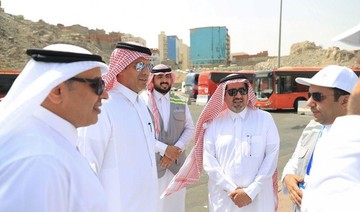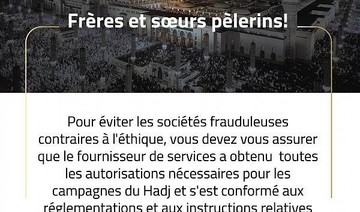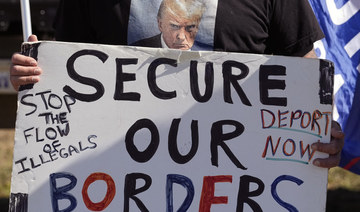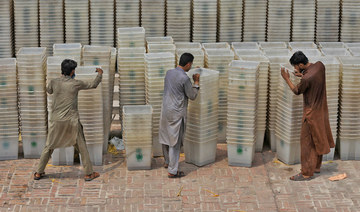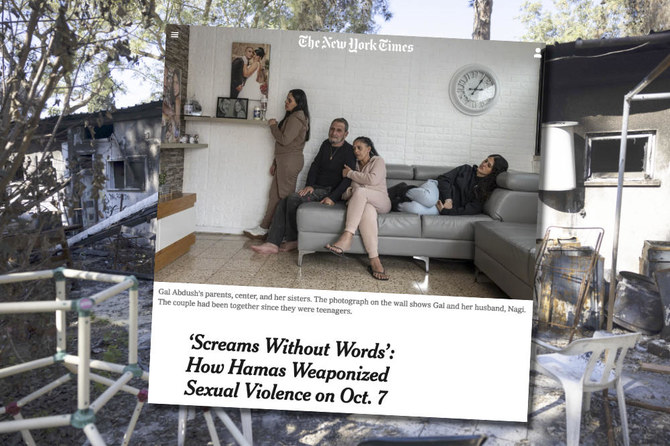MAKKAH: The numbers alone are simply staggering — last year involving 40,000 civil servants, 17,000 civil defense personnel, eight air ambulances and 300 ambulances on the ground, 2,000 Saudi Red Crescent representatives — all with the same mission; to look after more than three million people from more than 80 countries speaking goodness knows how many different languages.
Hajj adds up to one of the biggest gatherings of humanity on Earth. By comparison, Christmas mass at the Vatican, with 11,000 in attendance, looks like an intimate occasion.
In terms of religious gatherings, only the Hindu pilgrimage, the Kumbh Mela, is bigger with about 100 million to 120 million participants. But that takes place over two months, not two weeks, and rotates around four different locations.
A big event demands a media operation on a commensurate scale. Sky News Arabia, to name but one network, is sending a team of 15, from the London, Cairo, Riyadh and Jeddah bureaus.
Some reporters will mingle with the masses in search of heart-warming stories of family reunions and dreams come true. Others will be in the air, circling overhead in police helicopters.
BBC Arabic, the British public service broadcaster's Arabic service, is sending “a small team, including a reporter and local producer.” Planning began in early June and the coverage will include digital and Facebook content.
This year the Saudi Ministry of Media said that it will be offering “state of the art facilities” to the 800 foreign journalists who are expected to descend on Makkah and its environs.
There are fully equipped media centers with computers, and a new online portal will be an official source of news and information about the Hajj.
By far outnumbering the “official” journalists are the so-called “citizen journalists” — essentially people recording their Hajj experience on their mobile phone and posting it on social media, with the full blessing of the authorities.
While news outlets have to apply for permits to film or record, pilgrims taking selfies to post on Instagram face no such restrictions.
Arab-American Muslim journalist Anisa Mehdi said that Dr. Saud
Kateb, then Saudi Minister of Culture and Information, told her in 2013: “We’re all about citizen journalism now.”
In 1998, Mehdi, who is half-Iraqi, became the first US journalist to cover the Hajj for television. “It was the hardest thing I’ve ever done,” she said. “It wasn’t necessarily the government getting in my way, although I had to plead my case when I got there with only a Hajj visa and wanted permission to film. I had to explain why it was essential for the audience I was serving to dispel misconceptions and they (the Saudi authorities) understood that.
“There was simply no tradition of having journalists there so there were no facilities. There was nowhere for the cameraman to recharge the battery for the camera. He had to attach a cable to a car so I could continue an interview. There were no mobile phones so if you wanted to find someone you had to walk. It took more than four hours for me to find one subject in Mina. All I knew was that he was in Camp 19, but there were no maps and it was 110 degrees Fahrenheit.”
Mehdi returned in 2003 for National Geographic and again in 2014 for the Public Broadcasting Service (PBS) series “Sacred Journeys.” Despite having all the necessary permits, she and her crew were prevented from filming at the entrance to the plaza leading to the Haram.
The solution, which saved both time and hassle, was to distribute small cameras to Hajjis and let them capture the atmosphere in their own way. The minister approved, maintaining it was a good way to project a positive image.
“It’s not only the mainstream media. For non-Muslims it’s good to see the real Muslims,” Kateb told PBS. “Muslims are not having the right image all over the world, and I think we have a big responsibility to show who real Muslims are.”
The fact that the Hajj is a Muslim ritual does not mean that it holds no interest for non-Muslims.
“If you look at press coverage year in, year out, the main reason for interest in the Hajj outside the Muslim world is firstly that it’s perhaps the largest gathering of so many people from so many different parts of the world together in one place at one time,” said Dr. Sean McLoughlin, professor of the anthropology of Islam at Leeds University, who studies Muslim diasporas.
“Another headline issue that has featured periodically in the UK is the radical expansion of the Haram and the commercial redevelopment of Makkah in recent years, and especially the impact of this on Muslim history and heritage.
“However, beyond this focus on the infrastructural and organizational side of Hajj, the journeys of the pilgrims are also a genuine human interest story.”
McLoughlin said that US network CNN pioneered coverage from the Holy Places more than a decade ago. A 2003 documentary on Channel 4 in the UK “gave a genuine insight into pilgrims’ religious motivations an experiences of the sacred journey,” he added.
“There is a fascination too with the spiritual magnetism of perhaps the last place on Earth that non-Muslim Westerners cannot visit.”
In fact, CNN’s coverage of dates back 30 years, but the network is not sending a team this year because resources are taken up with covering other breaking news stories in the region.
The media — both mainstream and social — have an important part to play in challenging the perception of Muslims as “other,” said Dr. Chris Allen, associate professor at the Center for Hate Studies at Leicester University.
“In Britain, religion is a private matter. For Muslims, that line between the public and personal is less clear. If it’s presented well, without the element of preaching, if it focuses on the human story, then coverage of the Hajj has the potential to draw people into what, in Britain at least, is a niche subject.”
Does that mean Hajj is best explained to a Western audience by Western media?
“There is, in fact, very little of the ‘weird practices’ type of reporting,” said Allen. “Stories about people being fleeced by scam Hajj tour operators is not negative reporting, it’s legitimate consumer affairs journalism.
“Reporting on a tragedy like in 2015, when people died in a stampede, is not negative. It was newsworthy. There is an interest in Hajj, but it’s not a sinister interest.”
The influence of social media should not be dismissed, he added.
“The reach may be smaller and more localized than mainstream media, but put a lot of those smaller networks together and it adds up.”
He recounts how staff at his daughter’s workplace rearranged the rota so that a Muslim colleague was able to be at home for iftar during Ramadan.
“He was the only Muslim in the place and the reason the non-Muslims understood about Ramadan was because he had spoken about it. Small numbers can make big changes,” said Allen.
The success of the 2012 exhibition “Hajj: Journey to the Heart of Islam” at the British Museum in London demonstrated the growing appetite for better understanding of the Hajj, said Professor McLoughlin.
Several UK production companies have sought to make documentaries since then. BBC One was planning to run a two-part series following Nadiya Hussain, winner of “The Great British Bake Off,” on her Hajj.
While these projects have not all been realized, there is ample evidence that the importance of good media coverage is well-recognized.
Last year the Muslim Media Practitioners of Nigeria organized a conference in Lagos to “examine how robust media coverage can enhance the performance of the spiritual exercise.” It was attended by the Lagos State Deputy Governor, the Commissioner for Home Affairs, the National Hajj Commission of Nigeria, States Pilgrims Welfare Boards, private tour operators and airline representatives as well as the media.
McLoughlin said that the new media facilities fit into Saudi Arabia’s plan to expand Hajj and Umrah numbers significantly in the next decade to increase the role that religious tourism will play in the national economy. But there is more to it than that, he added. “Hajj has always been a focus for intra-Muslim exchange and diplomacy.”
Mehdi is now executive director of the Abraham Path Initiative, an NGO that has opened up 2,000 walking trails through Jordan, Palestine and Israel, following the journey of Ibrahim/Abraham, a figure revered by Muslims, Christians and Jews alike.
“The aim is to promote understanding and bring people together,” she said. “And that’s the point of the Hajj too.”



